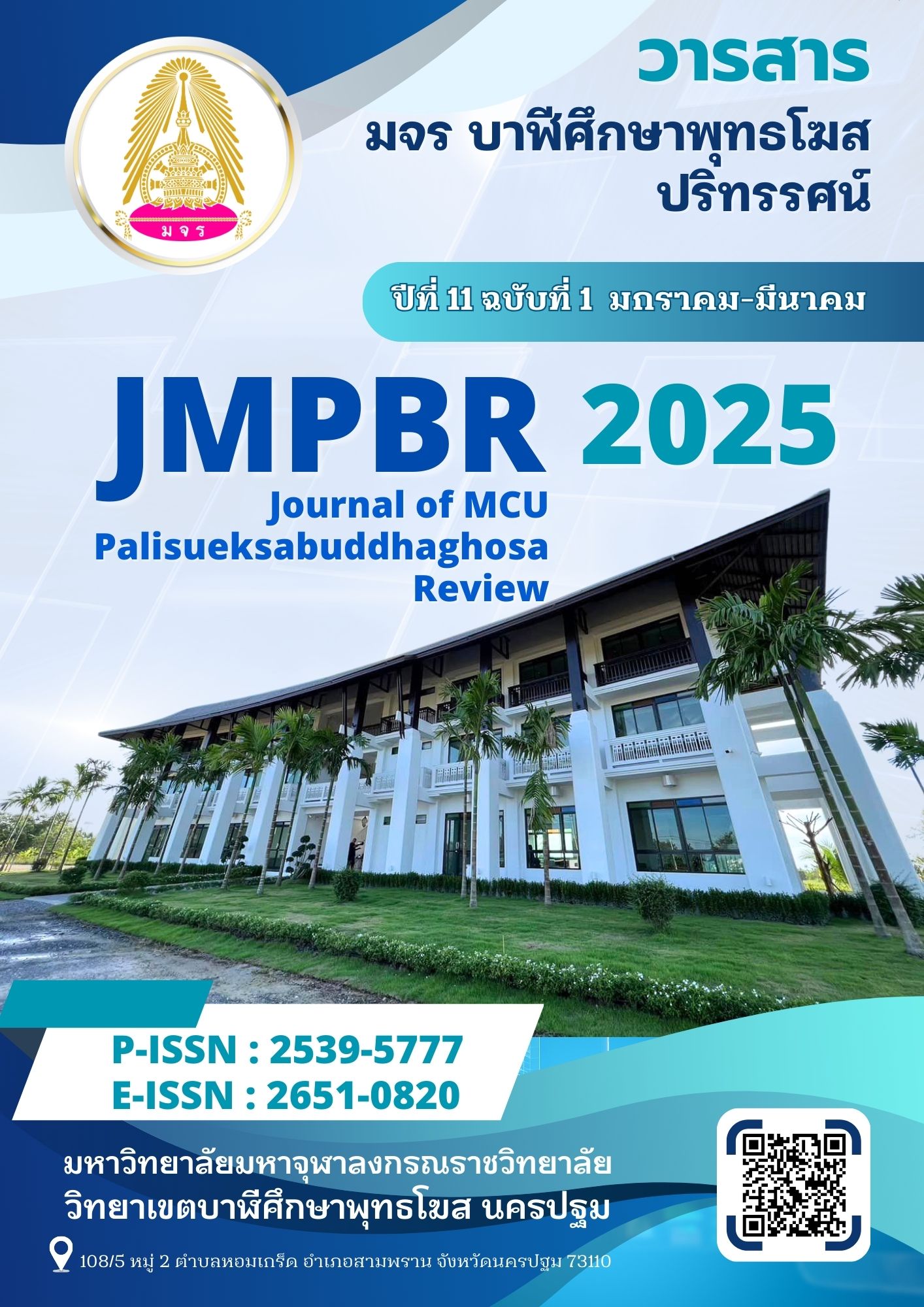Innovative Buddhist arts to develop mindfulness
Main Article Content
Abstract
Buddhist art during the Buddha's time Emphasis is placed on building for utility. Therefore, there appeared architectural works of Buddhist art such as various stupas, etc. and later in the era when the Lord Buddha passed away and passed away. Therefore, it appeared as a Buddhist art sculpture. That is, Buddha images were created according to the different eras that they respected. The researcher is a person who has seen Buddhist art since its birth. Therefore, the idea was born that if there was a device to help practice mindfulness for beginners. It will be beneficial to practice or develop more mindfulness. Thus, was born an innovation in Buddhist art to help develop mindfulness for beginners. Thus, was born an innovation in Buddhist art to help develop mindfulness for beginners. and many others who have already tried this innovation Answers to questions about starting to practice mindfulness Innovative Buddhist arts to develop this consciousness Therefore, it is a device that makes it easier for those who want to start practicing meditation. Therefore, it is named as "Mental Vehicle"
Article Details

This work is licensed under a Creative Commons Attribution-NonCommercial-NoDerivatives 4.0 International License.
Copyright Notice
The content and information in the articles published in Journal of MCU Palisueksabuddhaghosa Review, are regarded as opinions and responsibilities of article author only. It definitely does not mean that the editor must agree or share any responsibility to the author.
Articles, information, content, figure etc. that have been published in the Journal of MCU Palisueksabuddhaghosa Review is considered as the copyright of the Journal. If any individual or organization will to bring any parts of article for promote or to do anything, must be licensed only in official form from the Journal of MCU Palisueksabuddhaghosa Review.
The content and information in the articles published in Journal of MCU Palisueksabuddhaghosa Review, are regarded as opinions and responsibilities of article author only. It definitely does not mean that the editor must agree or share any responsibility to the author.
Articles, information, content, figure etc. that have been published in the Journal of MCU Palisueksabuddhaghosa Review is considered as the copyright of the Journal. If any individual or organization will to bring any parts of article for promote or to do anything, must be licensed only in official form from the Journal of MCU Palisueksabuddhaghosa Review.
References
กรรณิกา ณ สงขลา. “จิตรกรรมไทยประเพณี: เทคนิคและการอนุรักษ์”. ศิลปากร. ปีที่ ๓๓ ฉบับที่ ๕ (พฤศจิกายน – ธันวาคม ๒๕๓๒).
มหาจุฬาลงกรณราชวิทยาลัย. พระไตรปิฏกภาษาไทย ฉบับมหาจุฬาลงกรณราชวิทยาลัย. กรุงเทพมหานคร: โรงพิมพ์มหาจุฬาลงกรณราชวิทยาลัย, ๒๕๓๙.
ศิลปะ พีระศรี. “คุณค่าของจิตกรรมฝาผนัง”. กรุงเทพมหานคร: กรมศิลปากรจัดพิมพ์ถวายพระภิกษุและสามเณรซึ่งมาชมหอศิลปะและพิพิธภัณฑสถานแห่งชาติในเทศกาลเข้าพรรษา, ม.ป.ป.
สุชีพ ปุญญานุภาพ. ประวัติศาสนา. พิมพ์ครั้งที่ ๑๐. กรุงเทพมหานคร: บำรุงสาส์น, ๒๕๖๐.
อรวรรณ ศิลปะกิจ. (แพทย์หญิง). “การสร้างแบบประเมินสติ”. วิทยานิพนธ์พุทธศาสตรดุษฎีบัณฑิตสาขาวิชาพระพุทธศาสนา. บัณฑิตวิทยาลัย: มหาวิทยาลัยมหาจุฬาลงกรณราชวิทยาลัย, ๒๕๕๘.
Ryan T, A Mindful Nation: How a Simple Practice Can help Us Reduce Stress, Improve Performance, and Recapture the American Spirit, California: Hay House, 2012.


